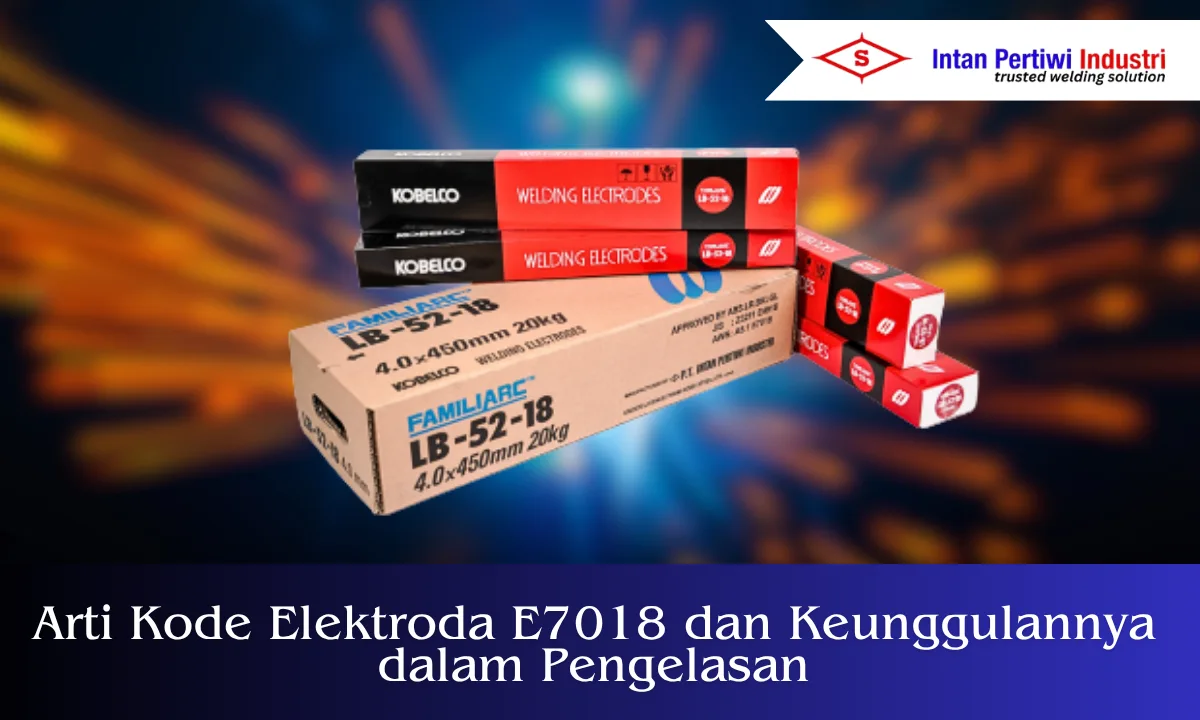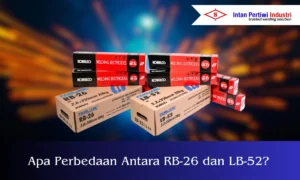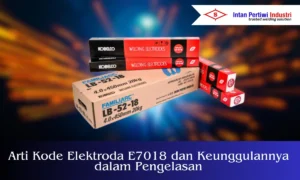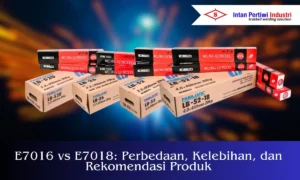The E7018 electrode is a low hydrogen electrode designed to maintain joint strength and reduce the risk of hydrogen cracking in critical structures.
Its stable arc characteristics, easy slag peeling, and neat bead appearance make it a mainstay for construction, vessels, and heavy fabrication.
Suitable for readers who:
Requires consistent welding results in steel structures
Compile or review WPS and process parameters
Looking for recommendations for diameter, flow, and proper storage practices
Table of Contents
ToggleWhat is E7018 Electrode?
The E7018 electrode is a low-hydrogen flux-coated electrode for carbon and low-alloy steels. The 70 designation indicates a minimum tensile strength of 70 ksi.
The low hydrogen character suppresses diffusible hydrogen in the weld metal, thus helping to prevent hydrogen-induced cracking, especially in thick materials and stressed joints.
Important points to remember:
Provides good impact toughness at medium service temperatures
Produces fine beads and controlled penetration
Suitable for fillet and groove joints in various thicknesses
Definitions and Standards
The E7018 electrode refers to the AWS A5.1 standard for carbon steel electrodes. This designation provides information about the strength, position, and type of flux.
Equivalent standards in the JIS system are available with comparable quality requirements.
For implementation, follow the approved WPS and product data from the manufacturer.
Bead Characteristics, Fracture Resistance, and Mechanical Properties
E7018 forms a full bead with a neat appearance. Its low hydrogen content maintains joint integrity and helps reduce the risk of cold cracking.
This is important in construction, heavy machinery, and dynamic applications.
Practical benefits:
Stable bow for easy pool control
A clean finished look that minimizes post-weld work
Mechanical performance suitable for dynamic structures and loads
Advantages of E7018 Electrode
The E7018 electrode is known as a reliable choice for demanding structures. The low-hydrogen flux formulation helps maintain joint integrity, while arc stability allows for easy control of the arc pool at various positions.
The result is a neat, strong, and consistent bead from root to cap.
What makes the E7018 stand out:
Excellent arc stability
The arc flame is smooth and easy to control, minimizing spatter and helping to form a uniform bead profile.Minimum tensile strength of 70 ksi
Suitable for structures and applications with dynamic loads that require toughness.Lower risk of hydrogen cracking
Low diffusible hydrogen content helps prevent cold cracking especially in thick materials.Slag is easily peeled off
Faster inter-pass cleaning so that work rhythm is increased without sacrificing quality.Neat bead appearance
Smoother weld surface which reduces finishing work after welding.Multi-position support
Can be used in flat, horizontal and uphill positions with proper technique adjustments.Convenient restart
Makes it easy to perform incremental work and local repairs in limited areas.Consistent with inspection
Helps achieve stable results for visual and non-destructive testing.WPS friendly
Clear parameter ranges facilitate the development and implementation of work procedures in the field.
Impact on productivity and costs:
Rework times are reduced thanks to consistent deposit quality.
Faster work cycle because slag is easily released
Controlling defects such as porosity and undercuts becomes easier with the right techniques.
When to Choose the E7018 Over Other Types?
The E7018 electrode is chosen when the top priorities are structural integrity, mechanical consistency, and hydrogen control.
For jobs that require more uphill pool control, some teams consider the E7016.
For general work on thin plates, E6013 is often used due to its ease of starting and moderate surface cleanliness.
In summary:
Choose E7018 for critical structures and reliable mechanical results.
Consider E7016 for vertical ups requiring a thicker pool.
Consider E6013 for light work and thin plates
Also Read : E7016 vs E7018
Technical Specifications of E7018 Electrode
Basic parameters help in quick decision making in the workshop and field.
Current and Polarity Compatibility
E7018 electrodes are typically used on direct current with DCEP polarity for arc stability and deposit quality. Some brands support AC current according to product data.
Follow the manufacturer's official information and approved WPS.
Welding Position Support
The E7018 electrode supports all positions with technique adjustments. The typical exception is vertical down. For vertical up, adjust travel speed and pool management with discipline.
Common Diameter Ranges in the Field
Commonly used diameters are 2.6 mm, 3.2 mm, 4.0 mm, and 5.0 mm. Diameter selection depends on material thickness, access area, and target fill rate.
Surface Cleanliness Needs
The joint surfaces need to be free from heavy rust, paint, oil and moisture to prevent porosity and fusion defects.
Quick checklist:
Clean the joint path in the fusion area
Adjust the bevel and root gap according to the joint design.
Ensure the fit up is stable to suppress distortion.
Initial Parameters and Ampere Table
The following figures are a realistic initial guide. Always conduct coupon testing before mass production and follow the WPS and manufacturer's data.
| Diameter | Ampere Range | Recommended Material Thickness |
|---|---|---|
| 2.6 mm | 60 to 90 A | 3 to 6 mm |
| 3.2 mm | 90 to 130 A | 6 to 12 mm |
| 4.0 mm | 120 to 160 A | 10 to 20 mm |
| 5.0 mm | 150 to 210 A | more than 20 mm |
Practical tips:
Adjust the flow at the root, fill, and cap to ensure a consistent bead profile.
Use a balanced travel speed to avoid undercuts.
Keep the arc length short to maintain pool stability.
Storage and Re Bake Practices
The performance of the E7018 electrode is significantly affected by humidity levels. Proper handling ensures its low-hydrogen properties remain effective.
Oven Storage, Re Dry Temperature, and Handling
Store the electrodes in a storage oven at 120 to 150 degrees Celsius. If the electrodes are exposed to the open air for too long or are damp, re-dry them at 260 to 315 degrees Celsius for 1 to 2 hours.
Always refer to the manufacturer's instructions on the box or official data sheet.
Signs of Excess Moisture and Mitigation Methods
Abnormal sparking, porosity, foamy beads, or unusual arcing sounds may indicate moisture.
Quick steps:
Perform re-drying according to manufacturer's recommendations.
Use a warm quiver in the field to keep the electrodes dry.
Minimize exposure to humid air and close the box immediately after collection.
QC Checklist to Prevent Hydrogen Cracking
Verify preheat requirements on certain thick or low alloy materials
Monitor interpass temperature on each pass
Make sure the slag is peeled off cleanly before the next pass.
Quick Comparison of E7018 vs E7016 vs E6013
Electrode selection depends on quality, position and productivity goals.
Outline:
E7018 for critical structures with hydrogen control and high toughness
E7016 for good pool control on vertical up
E6013 for general work and thin plates
E7018 Electrode Recommendation
KOBELCO LB-52-18 E7018
LB 52 18 is a trusted choice for heavy structures and fabrication. It combines arc stability, a neat bead, and easy-to-peel slag, allowing for increased work speed without sacrificing quality.
Simple advantages:
Consistent mechanical results on structures
Convenient restart for step-by-step work
Deposits support visual and NDT testing well
For official parameter consultation and ordering, visit the product page KOBELCO LB-52-18 E7018.
Implementation Guide in Project
Neat procedures facilitate quality control and repeatability.
Setting up WPS and PQR for E7018
Define current ranges, voltages, travel speeds, preheat, interpass, and multi-pass techniques. Validate parameters through PQR to establish a documented test basis.
Coupon Testing Procedure and Acceptance Criteria
Conduct visual, bend, and, if necessary, impact tests according to project standards. Document the results as a basis for audits and continuous improvement.
Common Mistakes and How to Avoid Them
Arc is too long which triggers spatter and porosity
Interpass too high which changes the bead profile
Exposure to moisture on unmanaged electrodes
Quick solution:
Keep arcs short
Monitor the temperature on each track
Implement oven and quiver procedures in a disciplined manner.
Short Case Study
Groove joints on 16 mm plates were machined with 4.0 mm diameter E7018. With moderate preheat and measured interpass control, the deposit was stable and the bead was homogeneous.
Bend tests showed good flexibility with no indication of cracking. Rework time was reduced thanks to cleanly removed slag and a neat stamp profile.
Important lesson:
Disciplined thermal control is the key to consistency
Penyimpanan dan re dry menjaga karakter low hydrogen
Pemilihan diameter yang tepat mempercepat progres tanpa mengorbankan mutu
Conclusion
E7018 is a trusted solution for structural joints that require strength and toughness. With measured parameters, proper storage practices, and proper diameter selection, welds are consistent and reliable.
FAQs
What is the E7018 electrode for?
For welding carbon and low alloy steels in structures, bridges, vessels, shipping, and component repairs. Reduces the risk of hydrogen cracking, provides a neat bead, and supports multi-position work with stable pool control.
What type of electrode is E7018?
SMAW electrode coated with low hydrogen type flux with basic slag. Designed for all positions except vertical down. Generally uses DCEP direct current, some brands support AC current according to manufacturer data and WPS.
What does the number 70 mean on the E7018 electrode?
The number 70 indicates a minimum tensile strength of the weld metal of 70 ksi. This value indicates the joint's ability to withstand tensile loads in heavy structural and fabrication applications when the correct parameters and procedures are applied.
What is the difference between E7018 and E6010 electrodes?
E7018 is low hydrogen with fine beads, high toughness, and is suitable for structures. E6010 is cellulose flux, deep penetration, fast solidification, ideal for root passes and pipework with different technical requirements.
What does the letter e mean in E7018?
The letter E stands for electrode in the AWS standard for the SMAW process. The code then describes the tensile strength, welding position, type of flux film, and recommended current for the appropriate work procedure.








